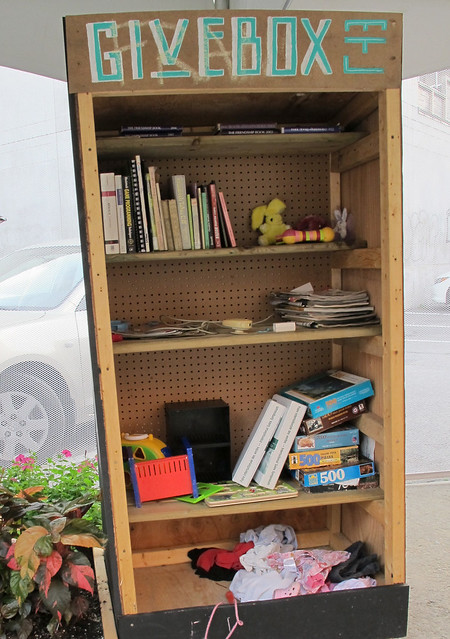
When I was in Berlin last month, I was interested – but not surprised – to stumble upon what looked like a walk-in closet in the middle of a Prenzlauerberg neighbourhood park. Not surprised, because the Umsonst Box (free box) made perfect sense in a city where DIY meets pop-up-urbanism on every street corner.
Happily, Local Montréal walking tours and Une banane design collective teamed up this summer to create Givebox Montreal. Frédérik-Toran Nissen, one of the creators, said that the design team got a small grant from Avenue Mont-Royal to create three Giveboxes as a temporary installation piece at plaza in front of Mont-Royal metro station. Once the installation was over, Nissen and his collaborators decided to place the boxes in neighbourhoods.
But, Montreal not being Berlin, Nissen needed find spots where Givebox could more or less fall through the cracks between public and private space. The first one landed on the little terrace in front of Épicerie Latina on Saint-Viateur. Nissen says it’s worked well, with new objects showing up and disappearing every day, and they are planning to install doors so that it can last the winter.
When Plateau Mayor Luc Ferrandez happened up the Givebox team constructing the boxes, he suggested a second location on Gilford and Rivard, a block that has been pedestrianized for the summer. The box is set up alongside terraces, hammocks, potted plants, and a giant sandbox. Nissen says he drops about once a week to maintain the boxes, but he’s pleased to see that others have also appropriated the project by cleaning out some of the junk that may accumulate over time.
The Saint-Viateur spot is good until late September but after that Givebox Montreal will need to find a new location – your suggestions are welcome in the comments below.
But wait: aren’t the streets of Montreal essentially one big informal Givebox?
“Les montréalais sont très cool au niveau du partage,” says Nissen. Rather than being a place for your neighbours to pick through your trash for a few hours before the garbage truck carts it off, Nissen encourages people to share special and unique items in the Givebox. The project aims to create interesting encounters around the Giveboxes, and there’s also a notebook where visitors to the Givebox can record the treasures they’ve found. Some things that have been shared in the past few weeks include hats, books, toys, clothing, a TV and a phone.
“Venez chercher quelque chose de gratuit, ça vaut la peine!” Nissen says.


One comment
Thanks Alanah. A performance artist by the name of Thomas Hirschhorn, has created a series of installations which I believe he calls “Kiosks”. These installations are made using common materials such as cardboard, foil, duct tape, and plastic wrap, which is a “political” decision as he only uses materials that are “universal, economic, inclusive, and don’t bear any plus-value…”
(http://en.wikipedia.org/wiki/Thomas_Hirschhorn)
These installations have been mounted in public spaces and have been commissioned as monuments commemorating Spinoza (1999), Deleuze (2000) and Bataille (2002), with a fourth planned to commemorate Antonio Gramsci. (For more on Thomas Hirschhorm, see also Hal Foster’s article “Towards a Grammar of Urgency” in New Left Review 68 Mar Apr 2011.). If the Giveboxes were repackaged as inter-active performance installations with the gift and exchange activity encouraged as part or the exhibit and if, furthermore, these Giveboxes were each named after a local person or event which is respected and would probably have supported the initiative and its intention (i.e. Gerard Godin on the Plateau, Jeanne Mance on Jeanne Mance and Joe Beef in the Old Port) then the Giveboxes could become not only a local curiosity, but a tourist attraction and treasure seekers destination as well as a meeting point for Artists, Students, Agent Provocateurs and Occupiers of all hues and tendencies and thereby enhancing the project chances of longevity.and the possibility of obtaining municipal support as well as needed municipal funding for installation maintenance.
Yours
Alan PS – It would also be advantageous to get a French name for the concept.